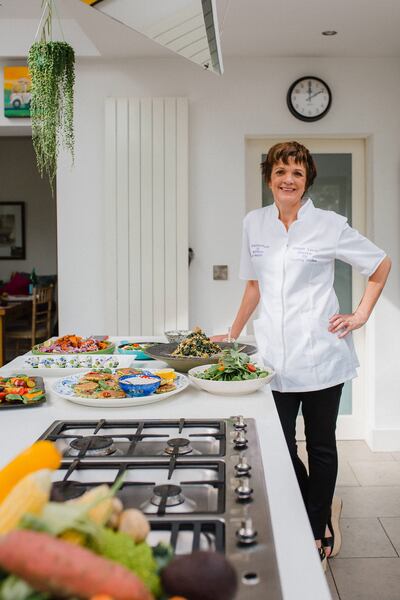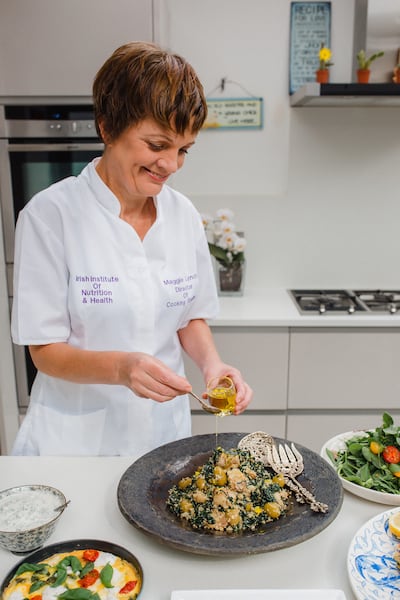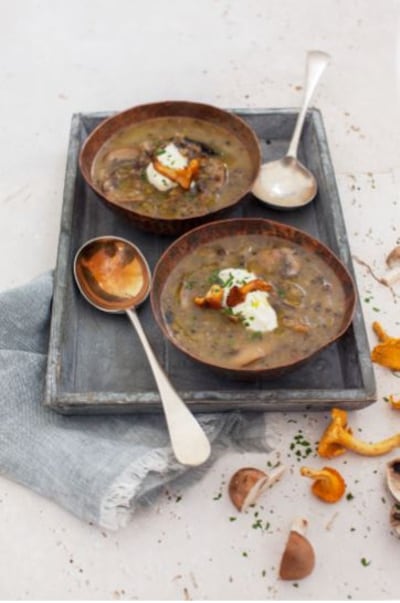With almost 10,000 people dying of cardiovascular-related disease in Ireland every year, what can the average person do to help nurture their heart health?
Nutrition is a key factor, so here are five recommendations.
1) Enjoy more veggies
Increase the intake and diversity of the vegetables you eat. They are an important source of vitamins and minerals and are rich in antioxidants and other phytonutrients that are good for heart health. They are also high in fibre and low in calories.
– Aim for six different-coloured vegetable servings – cooked or raw – each day. The dark green, leafy ones (kale, cabbage, spinach etc) are best of all, and my favourites.
– Use them in your smoothies, as dips with hummus, and in soups and stews. Refrigerate leftovers for the next day or blend them into pasta sauces and freeze.
2) Do a grain ‘swap’
Replace refined, white grain products with wholegrains. They are a richer source of fibre, protein, minerals and B vitamins.
– Swap white bread, pasta and wraps for wholegrain versions.
– Introduce quinoa, millet, buckwheat, pin-head oats, beans and lentils.

3) Embrace ‘good’ fats
Omega 3 oils are known to boost cholesterol quality by raising the level of HDL ('good' cholesterol) in the blood and helping reduce inflammation in the body. Oily fish (mackerel, salmon, sardines etc) are naturally rich in omega 3, while walnuts, flax and chia seeds are useful plant sources.
– Eat a serving of oily fish twice weekly.
– Drizzle good oils over your food. I use unrefined, cold-pressed oils (Udo's Oil, organic rapeseed, or extra virgin olive oil) as the goodness has not been processed out of them. Udo's is a quality vegan source of omega 3, 6 and 9.
– To avoid damaging their health benefits, it's best not to use these oils for cooking or frying. I use olive oil (not extra virgin), unrefined sesame oil, butter and coconut oil.
4) Choose low-sugar berries
Eat low-sugar berries (blueberry, blackberry, raspberry, strawberry) often. They are rich in antioxidants, fibre and phytonutrients that offer protection from cardiovascular disease. Be sure to wash them before eating.

5) Do a ‘protein mix and match’
Animal meat and specific vegetables are excellent sources of protein but don't feel you have to eat meat every day.
– Add in beans, chickpeas and lentils. They are high in protein and some B vitamins and minerals. Find recipes that help you incorporate them into your diet.
– Buy meat which is the least processed (fresh cuts and organic or free-range chicken). Avoid preserved meats as many contain high levels of salt and potentially harmful preservatives (nitrates and nitrites).
WILD MUSHROOM SOUP
This soup freezes really well, so you can make it ahead of time. If you cannot source wild mushrooms, white button mushrooms will suffice. Just use the same weight. Serve with homemade brown bread.

Ingredients
Serves 6-8
- 50g butter
- Dash of olive oil
- 1 medium onion, finely diced
- 3 cloves garlic, finely grated
- 1 leek, finely chopped
- 1 small celery stalk, finely diced
- 1 heaped tbs thyme leaves, chopped
- 4 medium potatoes, diced small
- 1 litre homemade vegetable stock or 2 Kallo vegetable stock cubes in one litre of boiling water
- 20 dried mushrooms (mix of any: porcini, oyster, Shiitake, chestnut), soaked in 400ml boiling water for at least 30 minutes
- 500g fresh chestnut mushrooms, finely sliced
- 200g fresh Portobello mushrooms, finely sliced
- 100g fresh Girolle/Chanterelle mushrooms, finely sliced (save a few for garnish)
- 300ml reserved mushroom liquid from soaking
- 20g fresh parsley, finely chopped
- 200ml crème fraîche
- Juice of ½ small lemon
- Udo's Oil to drizzle
Method
Place dried mushrooms in a small bowl, cover with boiling water and leave for at least 30 minutes or overnight. Drain and finely chop mushrooms, then set aside along with reserved soaking liquid. Fold lemon juice into the crème fraîche, set aside in the fridge until ready to use.
Melt one third of the butter and all of the olive oil in a saucepan at a low heat. Add garlic and cook for one minute, then add the onion, celery, leek and thyme and gently cook for five-10 minutes. Add the diced potato and dried mushrooms and cook until soft (10 minutes).
While onion mixture is cooking, prepare and cook mushrooms: in a separate pan, melt the remaining butter, add the sliced mushrooms in batches and quickly fry off on a medium heat until lightly coloured. Season as you go. Transfer mushroom plus any liquid from them to a bowl.
Add the cooked mushrooms to the onion mixture along with hot vegetable stock and reserved mushroom liquid, bring to a gentle simmer for about 15 to 20 minutes, then remove from heat. Pour half the soup into a blender (or use a blender stick), whizz into a purée then pour it back into the pan and return to a simmer. Add chopped parsley and season to taste.
Serve soup in warmed bowls, top with crème fraîche and drizzle with Udo’s Oil just before serving.
Maggie Lynch is a nutrition and health coach, and director of cooking at the Irish Institute of Nutrition and Health




















